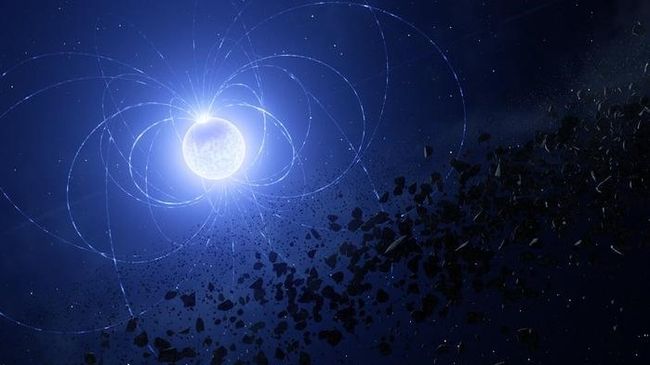A recent study has discovered that a deceased star in our galaxy, adorned with a distinctive ‘metal scar’ on its surface, is believed to have devoured a neighboring planet.
Researchers suggest that the presence of a “metal scar” on the surface of WD 0816-310, a white dwarf star, may indicate the remnants of a planet that was once destroyed.

A peculiar white dwarf star with a metallic scar on its surface has been discovered by astronomers. This scar is the remnants of a planet that was unfortunate enough to be consumed by the star. Known as WD 0816-310, this white dwarf is a dense remnant of a dead star located 63 light-years away from Earth. Previous assumptions suggested that the fragments of planets or asteroids consumed by white dwarfs would be evenly distributed across their surfaces. However, new observations of the Earth-sized remains of this dead star have revealed that the leftovers from its meal became trapped in place by powerful magnetic fields, resulting in a dark streak of metal on its surface.
Lead author Stefano Bagnulo, an astronomer at Armagh Observatory and Planetarium in Northern Ireland, explained that it is well-known that some white dwarfs, which are the cooling remnants of stars like our Sun, consume pieces of their planetary systems. The recent discovery highlights the significant role played by the star’s magnetic field in this process, leading to the formation of a scar on the white dwarf’s surface.
White dwarfs are formed when stars, ranging from one-tenth to eight times the mass of the Sun, deplete their nuclear fusion fuel. As a result, the outer layers of these stars are shed, revealing a compact and dense core that gradually cools over time. Approximately 97% of the stars in the Milky Way, including our Sun, are predicted to become white dwarfs, although many aspects of these ultra-dense objects remain mysterious.
To study WD 0816-310, researchers utilized the Very Large Telescope in Chile to observe the white dwarf for a period of two months. They observed that as the star rotated on its axis, the metals detected by the telescope underwent rapid changes that corresponded to variations in the white dwarf’s magnetic field.
The combination of these two observations suggests that the polar magnetic field of WD 0816-310 directed the metallic remnants of a celestial meal towards one of the white dwarf’s magnetic poles, resulting in a scar.
According to co-author John Landstreet, a professor emeritus at the University of Western Ontario and a visiting professor at the Armagh Observatory and Planetarium, “This scar represents a concentrated area of planetary material, anchored by the magnetic field that steered the falling fragments.” He added, “This phenomenon is unprecedented.”
The researchers believe that discovering more of these scarred remnants could provide valuable insights into star systems beyond our own, despite the fact that these observations are being made long after the demise of these systems.
Do not forget to share your opinion with us to provide you with the best posts !



0 Comments